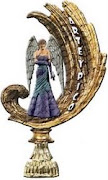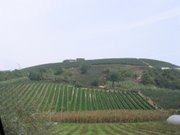We left Sakaiminato with a medium-heavy rain, which stayed with us for about one hour in the morning. It wasn't cold, so it wasn't too bad---it just made us wet and somewhat dirty. We stopped for breakfast at a fast food place recommended to us by Keisuke. The chain, called Mos Burger, makes Japanese variations of burgers. We tried one made with a bun of rice, teriyaki beef or veggies, and nori:
We kept biking for a while along highway 9. This wasn't as pretty as 431, but it was very well structured for biking, with large shoulders or ridable sidewalks:



From there we kept going east, passing some rural villages like this:
Tottori surprised us with its lively nightlife. Many young people were out, and there were lots of places to eat. We really liked it.
Here and there, we saw an Italian restaurant. Matt thought we should try one.
I resisted: Why go to an Italian restaurant in Japan, where the food would probably be bad? The point, Matt said, was to see what would happen if an actual Italian showed up in an Italian restaurant in a city where we had not seen any westerners. It did seem like an interesting idea.
So we randomly chose "Il piatto doro" (yes, unfortunately misspelled; it should have been "d'oro"). The restaurant was on the second story of a building and there was no plastic pasta outside, so we really had no idea about how it would be inside. When we arrived, we saw a small room, with seating only at a long, wide wooden bar, behind which there was a blackboard with the daily menu and shelves and shelves of wine bottles. It was run that night by just two people, the chef and a host. Just the right atmosphere for a small enoteca-like restaurant. The kitchen was at the end of the bar, separated from the dining area by a glass window.
When we sat down, I said, "Watashi wa Nihongo ga sukoshi wakarimasu. Demo, watashi wa Itariajin desu". This generated lots of surprised 'ooooohh', which are so typical of the Japanese expressive way of speaking. A habitue of the restaurant immediately ordered a bottle of wine and offered us two nice glasses of a really good barbera (a red wine from Piemonte!). Then, we had some grissini (breadsticks), and when I mentioned that they were made in my hometown we were given a lot of them as a gift for the trip.
After a small consultation, we decided we would have a pizza margherita. The chef asked if we wanted it Neapolitan or Roman style. This was already quite surprising: he evidently knew the difference in crust thickness and softness of the two styles! To make sure we understood each other, he showed me an Italian cookbook in Japanese with pictures of what each style should look like. We opted for Neapolitan, my favorite. We were told there would be some waiting, because the oven had been off. We enjoyed our wine and breadsticks, and the suspense.
Finally the pizza came. (I'm very sad I didn't bring my camera so I don't have pictures). The crust was perfect: puffy and soft at the borders, and very thin inside. The sauce was a bit lacking in salt, and there was too little cheese, even though it was good. However, overall the result was quite good, and I complimented the chef in all honesty.
We started chatting about Italian food, and he asked me my favorite dish. I thought and then replied 'gnocchi alla bava' (a type of gnocchi with really good cheese), and I started describing how hard I thought gnocchi were to prepare. The chef then disappeared, and we kept drinking more and more of the house wine and the barbera that the habitue kept offering us. Shortly later, the chef had prepared some gnocchi for us, even though they weren't on the evening's menu. They were amazingly good! They tasted like potatoes and were very soft. My respect for Japanese interpretation of Italian cuisine became very high after that. We left really happy, and quite drunk.
The morning after we were still tired from the long ride of the day before, so we decided to just bike and walk around Tottori. We changed hotel, opting for a very inexpensive Japanese style hotel. This was our bedroom:
This experience was very meaningful for us, because we were partially inspired to go to Japan by an article we read in Bicycling magazine. The American author had biked throughout Japan, and reported about the read bean sweets and green tea offered at a hotel as an example of strange Japanese food. He said he was able to 'gobble them down' only because he was so hungry from riding. Ah, these open-minded American tourists . . .
We spent the morning walking around Tottori's downtown, and asked for a recommendation for lunch at a coffee bean store we had visited. The suggested restaurant served us the best ramen we had during the whole trip:
In the afternoon, we went to the Tottori sand dunes. We made our way there on a bike path along a river:


To redeem the food, we went for Matt's favorite dessert, which he just discovered in Tottori the night before: Japanese green tea donuts, prepared at 'Mister Donut'. The sign of the store said 'from SF Chinatown', and as we learned, this chain indeed started in the US (more on the East coast, actually). However, there aren't many Mister Donuts left in the US, and of course they never served green tea donuts. The Japanese 'Mister Donut' donuts we tried were actually very good, said by someone who usually dislikes donuts.
To conclude this post, here is the route of our second day of bike touring. It was about 110 km, including ups and downs to find the hotel.
Saturday, August 08, 2009
Cicloturismo in Giappone II: da Sakaiminato a Tottori
Posted by
chemcookit
at
3:42 PM
![]()
Labels: cyclotouring, trip (Asia)
Subscribe to:
Post Comments (Atom)








No comments:
Post a Comment